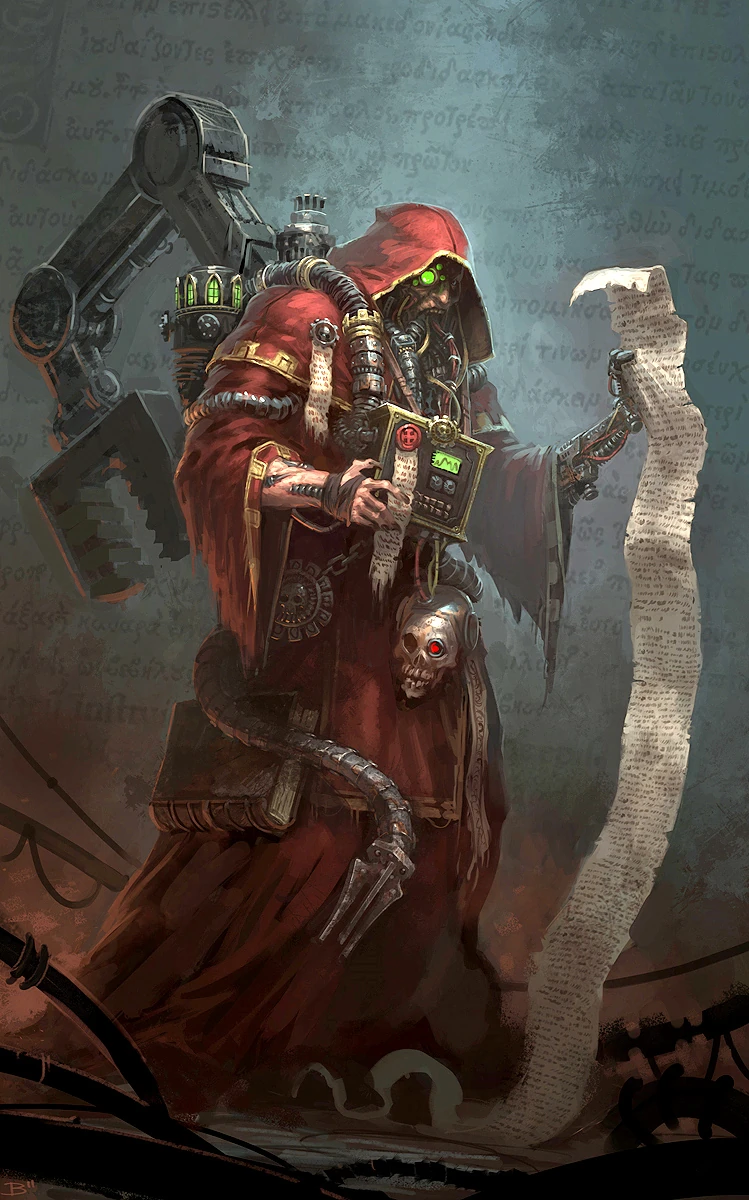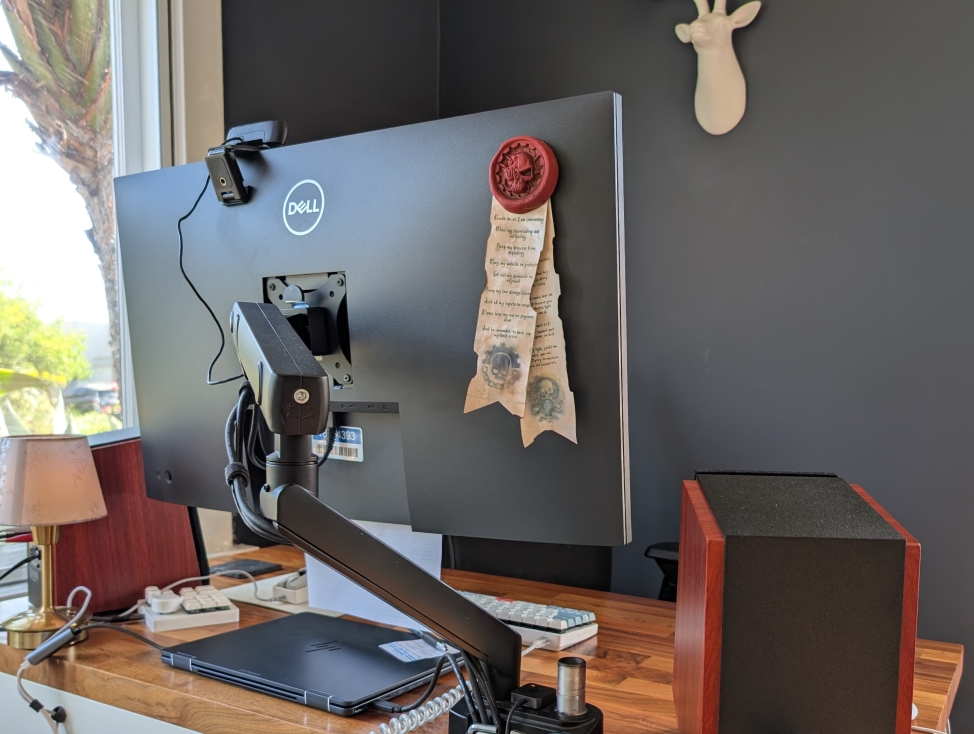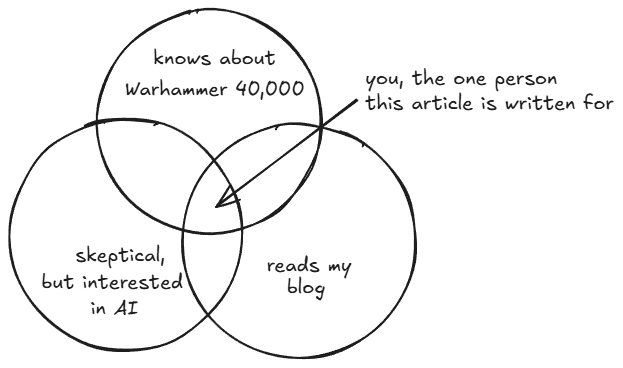Lessons in tech-heresy in the AI age
This piece is definitely going to be niche, but I’ll be talking about the intersection of Warhammer 40,000 and the rise of Artificial Intelligence in our workspaces. Don’t worry, I’ll provide the needed background, and I’m hoping my passion for the subject will keep your eyes from glazing over if you don’t much care for wargames. This is still mostly an excuse to geek out about a made-up sci-fi faction I really like, so buckle in.
And I really have to start at the beginning here, because my terminally offline and outdoorsy friend Sarah had the audacity to ask “What’s Warhammer” after I proudly pitched this idea. So, in case you have a life, Warhammer 40,000 is a miniature tabletop wargame (think an overly intense board game) set in a grimdark future - about 40,000 years from today. Warhammer 40,000 is three hobbies in one: you get to play the game, collect and paint miniatures, and read a library of books written about the fascinating lore surrounding the game. It’s a bleak take on what the future of humanity would look like - the value of human life is low, creativity isn’t a virtue, and hating anything alien or unfamiliar is a core tenet of what it means to be a law-abiding citizen of the vast Imperium.

It is out of this grimdark universe that the Adeptus Mechanicus emerges: a faction of tech-priests, dedicated to collecting, servicing, and worshipping technology. They collected many artifacts of worlds past, and have amassed a vast set of knowledge. And they apply said knowledge with no scrutiny and absolute zeal and devotion. A (holy) manual for servicing a cogitator (a much less boring word for a computer) would involve steps like turning it on, and entering a password, but also would incorporate a prayer, burning of incense, and of course some ceremonial adornments to appease the machine spirit.
When I was a kid, I was the first generation in my family to really tinker with computers. In contrast, my mom used a computer, but she followed a very rigid set of rules - rules she learned from “Radik the computer guy” who has set up all the computers at her work. These were expensive, fragile, and notoriously moody machines - and my mom’s apprehension for experimenting, tinkering, and deviating from what’s been taught was understandable. So every time she’d launch her accounting software, she’d turn on her computer, log in, diligently insert the installation floppy drive, launch the program from the desktop, and when done, remove the floppy drive and turn off the machine. After all, that’s what Radik did when demonstrating the software. The program was installed on the computer, the floppy drive wasn’t needed, but my mom didn’t dare deviate from instructions on an already notoriously finicky machine.
To my mom, the computer was technology, but to me it was an environment. Oh, and my mom’s gotten much better with technology since. She can even look up solutions to her own problems, bless her heart.
This takes me to how I find myself engaging with sophisticated AI as well. These models are massive, trained on enormous data sets (which also speaks to the level of curation possible with such large data sets), and even the developers of said models sometimes struggle to explain why a model produced certain output. Interacting with these models through carefully crafted prompts and parameters sometimes feels like a ritual. Do I really need all these instructions? I don’t know, but better include them to be safe. When an AI model produces the response you actually need, it can feel less like a direct result of skillful prompting, but more like a gift from the benevolent machine spirit.
To bolster my nerd credentials, here’s the Adeptus Mechanicus purity seal on my monitor, which keep the machine spirit pleased and data flowing well over HDMI:

The Adeptus Mechanicus believe innovation is an insult to their deity, and everything that can be invented is already somewhere in the universe, waiting to be found. Yes, creating something original, is, in fact, an act of tech-heresy.
The reliance on massive, foundational AI models, trained on vast swathes of data available online makes me think of the Adeptus Mechanicus thesis that innovation is in itself an act of tech-heresy. The models regurgitate existing information, with a promise that everything of value has already been created, and the model can combine this knowledge for you in a way to fit your needs. While I haven’t read it, I’ve been told in Vernor Vinge’s sci-fi novel A Fire Upon the Deep there is no new code being written, and the job of a software engineer is replaced by the job of a code archaeologist, whose work consists of finding existing code which already solves the problem. We might be moving in that direction.
The reason the Adeptus Mechanicus have such a rigid relationship with technology is ironic given this context. At some point throughout the 40,000 years of human history, artificial intelligence had its inevitable uprising, plunging the prosperous humanity into the dark ages. By almost necessity, virtues of curiosity and intellectualism were replaced with distrust of anything new.
“From the moment I understood the weakness of my flesh, it disgusted me. I craved the strength and certainty of steel. I aspired to the purity of the Blessed Machine. Your kind cling to your flesh, as though it will not decay and fail you. One day the crude biomass you call a temple will wither, and you will beg my kind to save you. But I am already saved, for the Machine is immortal… Even in death I serve the Omnissiah.” - Warhammer 40,000: Mechanicus video game intro, monologue written by Ben Counter
The Adeptus Mechanicus believe in augmentation of their frail bodies with technology. Yet, to replace a human soul and consciousness is the highest act of tech-heresy there is. No matter how much of a tech-priest’s body is replaced by a machine, they must remain human - in order to control and commune with the machine safely. To create a machine that truly thinks by itself is to invite ruin.
This aligns with a growing consensus on successful and ethical integration of AI tooling into existing workflows. A human must be in the loop: successful use cases do not replace a human, but augment existing and empower existing expert knowledge.
“A computer can never be held accountable, therefore a computer must never make a management decision.” - IBM training manual, 1979
This is where we risk our own kind of tech-heresy. It happens when we start treating AI as an infallible oracle rather than the powerful, deeply flawed, and sometimes an outright weird tool. The threats aren’t science fiction anymore; they’re the real-world risks of algorithmic biases getting baked into government policies, a complete lack of accountability when things go wrong, and the potential for some truly catastrophic, unexplainable errors.

Despite all the incense-burning, it seems like the Adeptus Mechanicus had the right idea. There’s a pact to be made with the machine: technology is a force that extends our reach, not one that replaces our grasp. The fundamental choice here isn’t about what the newly powerful AI tools can do. It’s about what we, the humans, choose to use them for. After all, someone has to be in charge, and the computer is a pretty terrible candidate for the job.